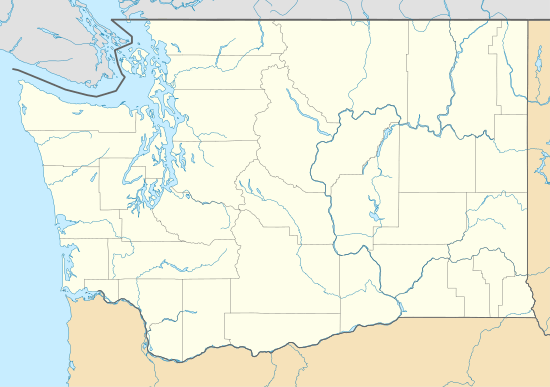Monroe Correctional Complex
 Location in Washington | |
| Location | Monroe |
|---|---|
| Coordinates | 47°50′37″N 122°0′7″W / 47.84361°N 122.00194°WCoordinates: 47°50′37″N 122°0′7″W / 47.84361°N 122.00194°W |
| Status | Operational |
| Security class | Minimum, medium, close, maximum |
| Capacity | 2,400 |
| Opened | 1910 |
| Managed by | Washington State Department of Corrections |
| Warden | Mike Obenland, Superintendent |
| Street address | 16550 177th Ave. SE |
| City | Monroe |
| County | Snohomish County |
| State | Washington |
| Postal code |
P. O. Box 777 (WSR/IMU) P. O. Box 7001 (MSU) P. O. Box 514 (SOU) P. O. Box 888 (TRU) |
| Country | United States |
| Website |
www |
Monroe Correctional Complex is a Washington State Department of Corrections men's prison located in Monroe, Washington, United States.[1] With an operating capacity of 2,500, it is the second largest prison in the state.[2] It opened 108 years ago in 1910, 21 years after statehood.
Monroe Correctional Complex is located at 16550 177th Avenue Southeast.
Organization
Monroe Correctional Complex is located on a 365-acre campus in Monroe, Washington.[2] On campus are six housing units:
- SOU
- MSU
- WSRU
- IPU
- TRU
- IMU
These vary from minimum to maximum security.[3]
Units
A segregation unit (Cell Block 3) provides about 80 beds for inmates who need to be temporarily removed from the general population.
MCC has an inpatient hospital that can also be used by other correctional facilities within the state. Major medical care can often be performed here, but serious surgical procedures are performed in community hospitals.
Vocational classes offered at MCC include printing, information technology and personal computer support specialist, and inmates can earn a GED while incarcerated. An independent non-profit, University Beyond Bars (UBB), offers college courses as a volunteer organization, and some people incarcerated at MCC have earned associate degrees despite the prohibition of state funding for post-secondary education.
A staff-supervised youth program is offered to high school and middle school students. It is designed to deter students from becoming involved in a criminal lifestyle by meeting selected inmates who tell them about the choices they made which led to their incarceration.
Class II and III jobs are located within MCC. Class III jobs provide essential services to the facility such as maintenance, janitorial, clerical warehouse workers, and kitchen work. Class II jobs are designed to reduce the cost of goods and services to state agencies and other tax-supported entities. These include laundry services, a print shop, a license tab shop, and the panel program. Class I industries were once housed at MCC, but were eliminated in July 2004 as a result of a Washington Supreme Court decision that held that inmates cannot be employed by private commercial enterprises.
Inmates have access to classification and mental health counselors at MCC, in addition to a wide range of paid and volunteer staff.
The other four facilities are the Minimum Security Unit (MSU), Twin Rivers Unit (TRU), Special Offenders Unit (SOU), and Intensive Management Unit (IMU). MCC comprises these five prisons, each within its own perimeter; they seldom mix. Offenders from one prison are not normally allowed to enter inside the perimeter of any other facility.
History
Monroe Correctional Complex opened 108 years ago in 1910, making it the second oldest operational prison in Washington state.[1]
On January 29, 2011, Officer Jayme Biendl was strangled to death with an amplifying cord by an inmate within prison walls. Inmate Byron Scherf was accused of the murder.[4] Officer Biendl had repeatedly filed work orders for additional security measures to her supervisors which went unanswered. One of her supervisors, Sergeant Jimmy Fletcher, signed a sworn affidavit that he had signed one of the work orders and forwarded it up the chain of command. In reaction to the murder, officers at MCC now carry pepper spray and a "panic button" in case of emergency, and inmates face higher restriction of recreational activities.[4]
Notable inmates
- James Fogle, author of Drugstore Cowboy, the novel on which the film of the same name was based[5]
- Glen Sebastian Burns, DOC #876360. Canadian murderer known for killing Atif Rafay's family in 1994.
- Atif Rafay, DOC #876362. Canadian murderer known for killing his family with Glen Sebastian Burns in 1994.
See also
References
- 1 2 http://www.doc.wa.gov/facilities/prison/mcc/
- 1 2 http://www.heraldnet.com/article/20120122/BLOG48/701229955
- ↑ http://www.prisonpro.com/content/monroe-correctional-complex
- 1 2 http://www.seattletimes.com/seattle-news/big-changes-under-way-at-monroe-prison/
- ↑ http://www.seattlepi.com/local/article/The-real-Drugstore-Cowboy-dies-in-state-prison-3812901.php